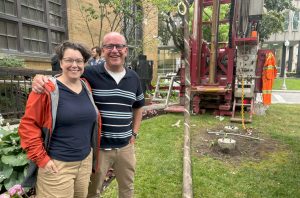Coming home isn’t always easy after leading a life on the international art scene, but photographer Edward Hillel’s visceral connection to the Main has welcomed him back. Until Sept. 15, his interactive solo exhibition at the Museum of Jewish Montreal, Darkroom, gives viewers the opportunity to see into the pages of his 1987 book, The Main: Portrait of a Neighbourhood, and connect it to today.
He does this by mounting translucent ghosts of needle trade workers and Main residents of 30 years ago on the museum windows, and by inviting gallery-goers to place stickers on their favourite Main haunts on a wall-size map of the area. Called Titled Footprints, the map also collects viewers’ stories and experiences on handwritten Post-It notes that will be compiled into a journal by museum staff. Hillel has added his own footprints among those of the other contributors.
His artistic photography of the Main inspired him to do similar projects in various cities worldwide, from Manchester, to Harlem’s 125th Street. He always had an international outlook. Born in Baghdad, Hillel immigrated to Montreal at age 10 and made the Main his stomping grounds at 18 for the following 20 years, before moving to Paris and then New York to set up a studio. Yet Montreal, where his mother and the Main reside, always draws him back.
“Working on my first book about the Main was a real foundation for my thinking,” says the artist. In it, he combines black and white photographs of Main denizens like Max (Boss) Rothstein of Rothstein Pants in the Peck Building and sculptor Edith Brodkin wrestling with a piece of stone above L. Berson & Son Monuments. Ragged youngsters, Hasidim, nuns, Greeks, Jews and Portuguese all add to the human tapestry. Hillel’s revealing descriptions – half interview, half impressions – bring each character and scene to life.
“In this museum, I wanted to use my archives from the book to create a dialogue with the street. I thought I’d use process as the main element of the show,” he says.
Enlarged contact sheets, which were used to choose which photos to develop in the days before digital cameras, are mounted on the museum’s back wall. They allow museum-goers to take a behind-the-scenes look at the process he used to create the images. Viewers may search for the ones he circled for the book and then locate them in hard copy form, or via a screen where pages turn digitally.
READ: GENEALOGIST HAS PHOTOGRAPHED 30,000 GRAVESTONES
On a panel marking the front boundary of the gallery is his 1978 photograph of a street accordionist and a unicyclist entertaining with freewheeling joy on a sunny afternoon. The details of how he made it, such as aperture and exposure, scanned from the verso, appear alongside and continue the theme of process.
When the museum is closed at night, the exhibit is bathed in red light that’s visible from outside, carrying on the idea of a darkroom. “A lot of young people come to the Main after 10 p.m. and stay until 3 in the morning. Hundreds of them lining up outside clubs and this glowing red corner building will be a point of entry for them to come back and see more of the show. Then they can take the stories and tell them again. That’s how you keep memory alive,” says Hillel, who is off to Krakow, Poland, to fulfill a commission for a new Holocaust museum in Guatemala.
For museum hours, go to imjm.ca. To see some of Hillel’s photos, visit edwardhillel.com.






